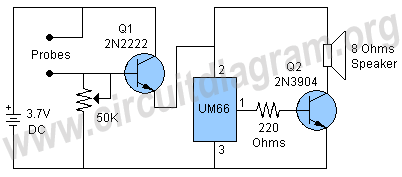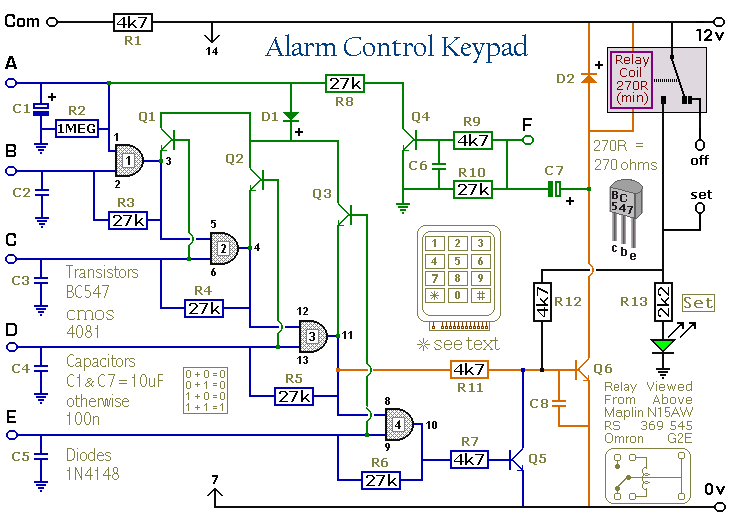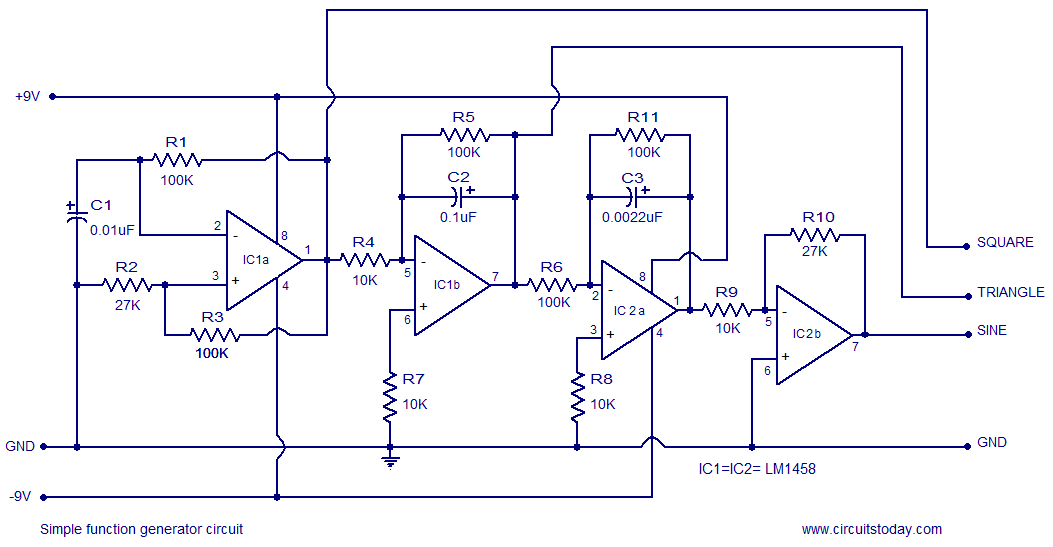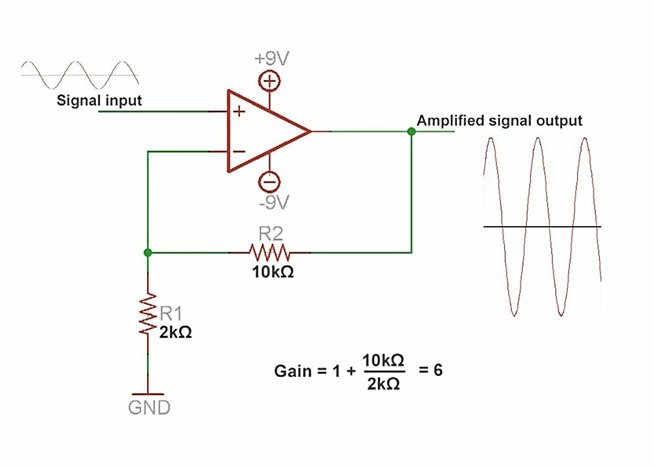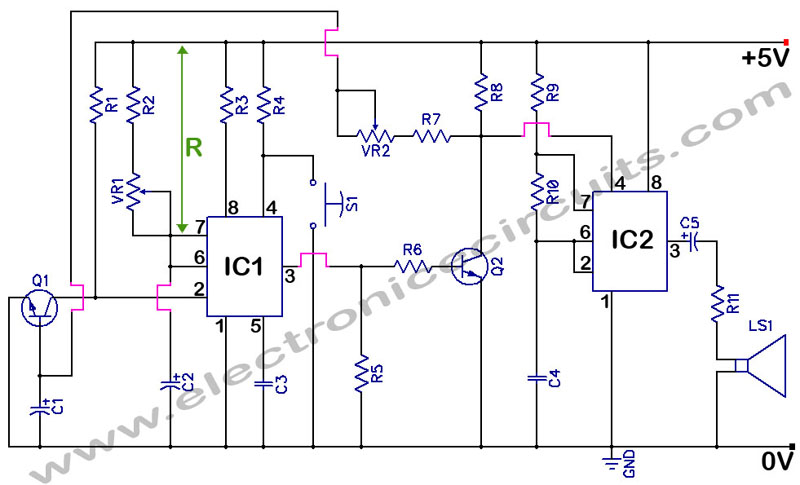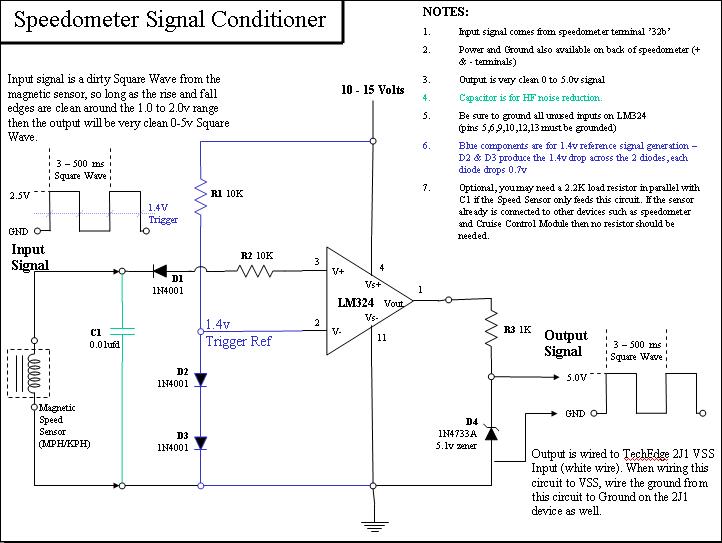
How To Build A Simple Car Alarm And Immobilizer
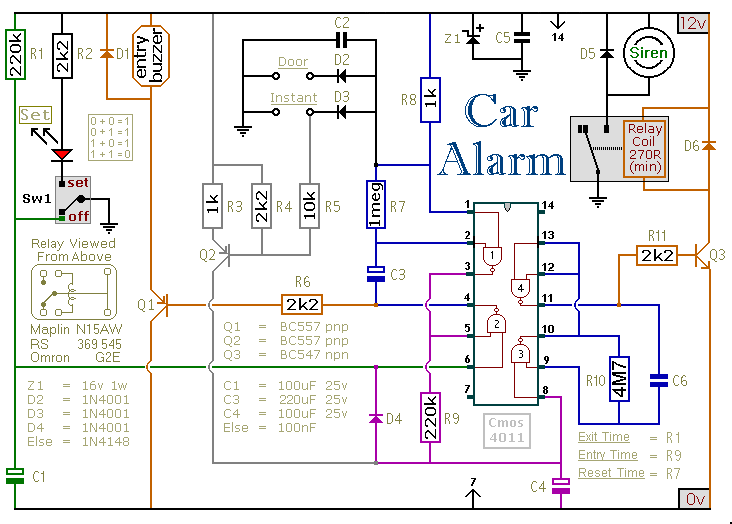
This circuit includes automatic exit and entry delays, an optional instant alarm zone, an optional intermittent siren output, and an automatic reset feature. By incorporating external relays, it is possible to immobilize the vehicle and activate the lights. For automatic functionality, a small relay can be used in place of Sw1, with the relay coil wired to energize while the ignition is on. Consequently, every time the ignition is turned off, the alarm will activate. Once Sw1 is opened, there is a delay of approximately 10 to 15 seconds to exit the vehicle and close the door. Upon returning and opening the door, a buzzer will sound, providing another 10 to 15 seconds to deactivate Sw1. Failure to do so will result in the siren sounding intermittently, with the on/off switching speed determined by C6 and R10. For a constant siren output, C6 and R10 should be omitted, and pins 8 and 9 of the Cmos 4011 connected together. One of the alarm inputs connects to the vehicle's existing door switches to facilitate the exit and entry delays, typically requiring only one wire connected to a single door switch. These switches are usually connected in parallel, with the return through the chassis. Additional normally-open switches can be added to the door circuit, but they must be capable of carrying the current needed for the vehicle's interior light. Any number of normally-open switches can be connected in parallel to the "Instant" input, as they do not need to handle the interior light current. Instant alarm switches can be placed on the bonnet, boot, rear hatch, or rear doors, even if they are already connected to the door circuit; a second switch can be fitted to connect to the instant input, overriding the delay circuit. The chassis can serve as the return, although a ground terminal is provided for a separate return wire if necessary. The exit delay is determined by R1 and C1, the entry delay by R9 and C4, and the reset time by R7 and C3. The exact duration of these time periods depends on the characteristics of the components used, particularly the capacitor tolerances and the Cmos gate switching points. However, precise timing is not critical for this application. While any trigger switch remains closed, the siren will continue to sound, and the alarm will reset approximately 2 to 3 minutes after all switches are opened. The circuit is designed to operate with an electronic siren drawing 300 to 400 mA. Using the vehicle's horn is typically discouraged due to its easy accessibility for disconnection. If the horn is used, a suitably rated relay must be connected to the "Siren" output to handle the necessary current for the horn and to manage flashing lights. The support material for this circuit includes a step-by-step guide for constructing the circuit board, a parts list, and a detailed circuit description. It is essential to protect the circuit board and switches from environmental conditions, as moisture can lead to malfunction. A 1-amp in-line fuse should be installed as close as possible to the power source for protection. The installation specifics will vary based on the vehicle make, and further installation advice cannot be provided. It is crucial to consider the safety implications of potential system failures and the legal consequences of installing devices that could cause accidents before proceeding with the installation.
This circuit serves as a comprehensive vehicle security system that integrates various functionalities to enhance the safety and protection of the vehicle. The automatic exit and entry delays are designed to provide users sufficient time to secure their vehicle without triggering the alarm inadvertently. The switching mechanism, relying on Cmos technology, ensures efficient operation with minimal power consumption. The inclusion of an optional instant alarm zone adds another layer of security, allowing users to monitor additional areas of the vehicle, such as the trunk or hood, which are often vulnerable to unauthorized access.
The use of external relays for immobilization and light activation is a strategic feature that enhances the deterrent effect of the alarm system. By wiring the relay to activate with the ignition, the system ensures that the alarm is armed whenever the vehicle is turned off, establishing a robust security protocol. The design accommodates various configurations, allowing for customization based on user preferences and vehicle specifications.
The alarm's sound output can be tailored to suit user needs, with the option for intermittent or continuous siren sounds, providing flexibility in alerting the owner or deterring potential intruders. The time delays for exit and entry are adjustable, offering users the ability to fine-tune the system to their specific requirements.
The circuit's reliance on existing vehicle infrastructure, such as door switches, simplifies installation while maintaining functionality. The design also considers the need for additional switches, ensuring that users can expand the system to cover more areas without compromising performance.
Overall, this vehicle security circuit represents a well-thought-out solution for enhancing vehicle safety, combining user-friendliness with effective security measures. Proper installation and adherence to safety guidelines will ensure reliable operation and long-term functionality of the system.This circuit features automatic exit and entry delays - an optional instant alarm zone - an optional intermittent siren output - and an automatic reset. By adding external relays you can immobilize the vehicle and flash the lights. For automatic operation - use the contacts of a small relay in place of Sw1. Wire the relay coil so that it`s energiz ed while the ignition is on. Then - every time you turn the ignition off - the alarm will set itself. Once Sw1 is opened you have about 10 to 15 seconds to get out of the vehicle and close the door behind you. When you return and open the door the buzzer will sound. You have 10 to 15 seconds to move Sw1 to the off position. If you fail to do so - the siren will sound. The output to the siren is intermittent. That is - it switches on and off. The speed at which it switches on and off is set by C6 & R10. If you want a constant siren output - leave out C6 & R10 - and connect pins 8 & 9 of the Cmos 4011 together.
One of the alarm`s inputs is connected to the vehicle`s existing door-switches. This provides the necessary exit and entry delays. It`s usually sufficient to connect a single wire to just one of the door switches. These switches are generally all connected in parallel - with the return through the chassis. You can add extra normally-open switches to the door-circuit if you wish - but note that any additional switches will have to be able to carry the current required by your vehicle`s interior light. Any number of normally-open switches may be connected - in parallel - to the "Instant" input. Since they don`t have to carry the current for the interior light - you can use any type of switch you like.
You may want an instant alarm on the bonnet - the boot - the rear-hatch - the rear-doors etc. It doesn`t matter if these already have switches connected to the door-circuit. Simply fit a second switch and connect it to the instant input. It will override the delay circuit. You can use the chassis for the return. However, a ground terminal is provided if - for any reason - you need to run a separate return wire for either zone. The exit delay is set by R1 & C1 - the entry delay by R9 & C4 - and the reset time by R7 & C3. The precise length of any time period depends on the characteristics of the actual components used - especially the tolerance of the capacitors and the exact switching points of the Cmos gates.
However - for this type of application - really accurate time periods are unnecessary. While any trigger-switch remains closed - the siren will continue to sound. About 2 to 3 minutes after all of the switches have been opened - the alarm will reset. The circuit is designed to use an electronic Siren drawing 300 to 400mA. It`s not usually a good idea to use the vehicle`s own Horn - because it can be easily located and disconnected. However - if you choose to use the Horn - remember that the alarm relay is too small to carry the necessary current.
Connect the coil of a suitably rated relay to the "Siren" output. This can then be used to sound the Horn - flash the lights etc. The Support Material for this circuit includes a step-by-step guide to the construction of the circuit board, a parts list, a detailed circuit description and more. The circuit board and switches must be protected from the elements. Dampness or condensation will cause malfunction. Fit a 1-amp in-line fuse AS CLOSE AS POSSIBLE to your power source. This is VERY IMPORTANT. The fuse is there to protect the wiring - not the alarm. Exactly how the system is fitted will depend on the make of your particular vehicle. Consequently, I CANNOT give any further advice on installation. Before fitting this or any other immobilizer to your vehicle - carefully consider both the safety implications of its possible failure - and the legal consequences of installing a device that could cause an accident.
If you decide to proceed - you`ll need to use the highest sta 🔗 External reference
This circuit serves as a comprehensive vehicle security system that integrates various functionalities to enhance the safety and protection of the vehicle. The automatic exit and entry delays are designed to provide users sufficient time to secure their vehicle without triggering the alarm inadvertently. The switching mechanism, relying on Cmos technology, ensures efficient operation with minimal power consumption. The inclusion of an optional instant alarm zone adds another layer of security, allowing users to monitor additional areas of the vehicle, such as the trunk or hood, which are often vulnerable to unauthorized access.
The use of external relays for immobilization and light activation is a strategic feature that enhances the deterrent effect of the alarm system. By wiring the relay to activate with the ignition, the system ensures that the alarm is armed whenever the vehicle is turned off, establishing a robust security protocol. The design accommodates various configurations, allowing for customization based on user preferences and vehicle specifications.
The alarm's sound output can be tailored to suit user needs, with the option for intermittent or continuous siren sounds, providing flexibility in alerting the owner or deterring potential intruders. The time delays for exit and entry are adjustable, offering users the ability to fine-tune the system to their specific requirements.
The circuit's reliance on existing vehicle infrastructure, such as door switches, simplifies installation while maintaining functionality. The design also considers the need for additional switches, ensuring that users can expand the system to cover more areas without compromising performance.
Overall, this vehicle security circuit represents a well-thought-out solution for enhancing vehicle safety, combining user-friendliness with effective security measures. Proper installation and adherence to safety guidelines will ensure reliable operation and long-term functionality of the system.This circuit features automatic exit and entry delays - an optional instant alarm zone - an optional intermittent siren output - and an automatic reset. By adding external relays you can immobilize the vehicle and flash the lights. For automatic operation - use the contacts of a small relay in place of Sw1. Wire the relay coil so that it`s energiz ed while the ignition is on. Then - every time you turn the ignition off - the alarm will set itself. Once Sw1 is opened you have about 10 to 15 seconds to get out of the vehicle and close the door behind you. When you return and open the door the buzzer will sound. You have 10 to 15 seconds to move Sw1 to the off position. If you fail to do so - the siren will sound. The output to the siren is intermittent. That is - it switches on and off. The speed at which it switches on and off is set by C6 & R10. If you want a constant siren output - leave out C6 & R10 - and connect pins 8 & 9 of the Cmos 4011 together.
One of the alarm`s inputs is connected to the vehicle`s existing door-switches. This provides the necessary exit and entry delays. It`s usually sufficient to connect a single wire to just one of the door switches. These switches are generally all connected in parallel - with the return through the chassis. You can add extra normally-open switches to the door-circuit if you wish - but note that any additional switches will have to be able to carry the current required by your vehicle`s interior light. Any number of normally-open switches may be connected - in parallel - to the "Instant" input. Since they don`t have to carry the current for the interior light - you can use any type of switch you like.
You may want an instant alarm on the bonnet - the boot - the rear-hatch - the rear-doors etc. It doesn`t matter if these already have switches connected to the door-circuit. Simply fit a second switch and connect it to the instant input. It will override the delay circuit. You can use the chassis for the return. However, a ground terminal is provided if - for any reason - you need to run a separate return wire for either zone. The exit delay is set by R1 & C1 - the entry delay by R9 & C4 - and the reset time by R7 & C3. The precise length of any time period depends on the characteristics of the actual components used - especially the tolerance of the capacitors and the exact switching points of the Cmos gates.
However - for this type of application - really accurate time periods are unnecessary. While any trigger-switch remains closed - the siren will continue to sound. About 2 to 3 minutes after all of the switches have been opened - the alarm will reset. The circuit is designed to use an electronic Siren drawing 300 to 400mA. It`s not usually a good idea to use the vehicle`s own Horn - because it can be easily located and disconnected. However - if you choose to use the Horn - remember that the alarm relay is too small to carry the necessary current.
Connect the coil of a suitably rated relay to the "Siren" output. This can then be used to sound the Horn - flash the lights etc. The Support Material for this circuit includes a step-by-step guide to the construction of the circuit board, a parts list, a detailed circuit description and more. The circuit board and switches must be protected from the elements. Dampness or condensation will cause malfunction. Fit a 1-amp in-line fuse AS CLOSE AS POSSIBLE to your power source. This is VERY IMPORTANT. The fuse is there to protect the wiring - not the alarm. Exactly how the system is fitted will depend on the make of your particular vehicle. Consequently, I CANNOT give any further advice on installation. Before fitting this or any other immobilizer to your vehicle - carefully consider both the safety implications of its possible failure - and the legal consequences of installing a device that could cause an accident.
If you decide to proceed - you`ll need to use the highest sta 🔗 External reference
